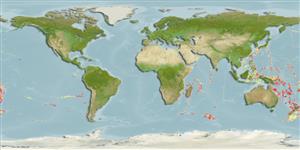Teleostei (teleosts) >
Gadiformes (Cods) >
Macrouridae (Grenadiers or rattails)
Etymology: Ventrifossa: Latin, venter, ventris = belly + Latin, fosa = pit (Ref. 45335).
Eponymy: This fish is named after two ichthyologists Dr ‘John’ Richard Paxton (q.v.), and Dr Robert ‘Bob’ John Lavenberg (q.v.), who first recognised that it was a new species. (See Lavenberg & Paxton) (Ref. 128868), visit book page.
More on author: Iwamoto.
Environment: milieu / climate zone / depth range / distribution range
Ecology
Marine; bathydemersal; depth range 540 - 810 m (Ref. 9949). Deep-water
Indo-Pacific: Western Indian Ocean. Western Pacific: Bismarck Sea and Papua New Guinea (Ref. 6993). Southeast Pacific: Sala y Gomez Ridge (Ref. 9949).
Size / Weight / Age
Maturity: Lm ? range ? - ? cm
Max length : 47.5 cm TL male/unsexed; (Ref. 9949)
A benthic species found on the continental slope (Ref. 75154).
Life cycle and mating behavior
Maturity | Reproduction | Spawning | Eggs | Fecundity | Larvae
Kailola, P.J., 1987. The fishes of Papua New Guinea. A revised and annotated checklist. Vol. 1. Myxinidae to Synbranchidae. Research Bulletin No. 41. Department of Fisheries and Marine Resources, Port Moresby, Papua New Guinea. 194 p. (Ref. 6993)
IUCN Red List Status (Ref. 130435: Version 2024-2)
Threat to humans
Harmless
Human uses
Tools
Special reports
Download XML
Internet sources
Estimates based on models
Preferred temperature (Ref.
123201): 2.3 - 9.7, mean 7.3 °C (based on 171 cells).
Phylogenetic diversity index (Ref.
82804): PD
50 = 0.5000 [Uniqueness, from 0.5 = low to 2.0 = high].
Bayesian length-weight: a=0.00575 (0.00194 - 0.01707), b=3.08 (2.83 - 3.33), in cm total length, based on LWR estimates for this (Sub)family-body shape (Ref.
93245).
Trophic level (Ref.
69278): 3.8 ±0.5 se; based on size and trophs of closest relatives
Resilience (Ref.
120179): Low, minimum population doubling time 4.5 - 14 years (Preliminary K or Fecundity.).
Fishing Vulnerability (Ref.
59153): Moderate vulnerability (38 of 100).
